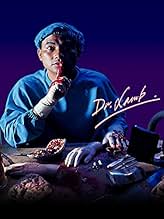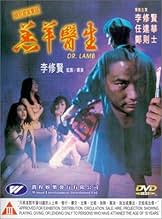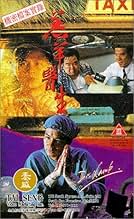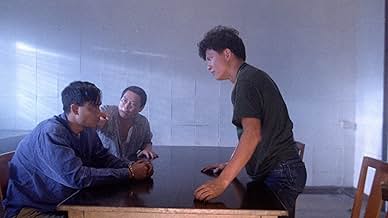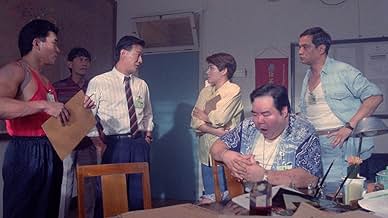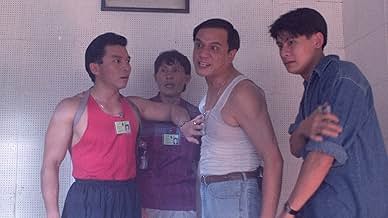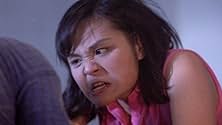IMDb-BEWERTUNG
5,9/10
998
IHRE BEWERTUNG
Ein abnormaler Taxifahrer giert in jeder Regennacht nach Blut, und infolgedessen werden mehrere junge Frauen getötet.Ein abnormaler Taxifahrer giert in jeder Regennacht nach Blut, und infolgedessen werden mehrere junge Frauen getötet.Ein abnormaler Taxifahrer giert in jeder Regennacht nach Blut, und infolgedessen werden mehrere junge Frauen getötet.
Handlung
WUSSTEST DU SCHON:
- WissenswertesBased on the life of Hong Kong serial killer Lam Kor-wan. He was arrested in 1982 after murdering four women.
- PatzerThe videotape of the final murder contains moving shots which would be impossible without someone to operate the camera.
- VerbindungenReferenced in Xiang Gang qi an: Xi xue gui li wang (1994)
- SoundtracksDream Person
Performed by Guang Bai
Ausgewählte Rezension
Acclaimed and charismatic Hong Kong actor Danny Lee made his directorial debut with this influential film from 1992. DR. LAMB is based on the true life murders that took place in Hong Kong in 1982 during several months. A taxi driver Lam Gor-Yu committed grisly murders on females he thought were "bad and filthy" and it was revealed that he thought he got his instructions and orders from God. He was caught after developing some photographs which concerned the workers in that camera shop who actually saw the photos. Lam (or "Lamb") photographed all his victims in various positions while he mutilated them or even raped after the killing. He was sentenced to prison (a life sentence) and at least in the film, everybody turned their backs on him, even his parents and relatives, and that is also one important point and theme in the film.
The film opens showing some kids play. Of course it is a short depiction of Lam's childhood as he grew in seemingly happy and safe family, but still he was very silent and had some abnormal habits like used to peep on his parents who made love at night (it is said in the opening that his real mother had left him or died and that he didn't live with his real parents, and that Lam missed his mother a lot as a child). He also secretly watched her sister taking bath and so on but still no one in their family did anything about it until the horrible photographs were found by accident. The family said to police that they never saw him and he was always alone in his room doing something, and driving the cab at night time. The film is told as a flashback as the film opens (after the kids scene) with the arrest of Lam in the camera store. Soon he starts to tell the police about his past and victims, but what he goes through before that isn't too nice or human.
The film is written by Law Kam Fai, who has written at least Kirk Wong's GUNMEN (1988), and co-directed by Billy Tang Hin Sing, who has made some depressing, nerve-shredding and ultra pessimistic (horror related) thrillers like RED TO KILL (1994) and RUN AND KILL (1993), the latter also starring Simon Yam in a perhaps even more frightening psycho performance than in LAMB. Billy really knows how to shoot atmospheric scenes and how to use light and darkness, and how wonderfully that shows in DR. LAMB! Easily the greatest thing in this impressive film is the cinematography by Kin Fai Miu, who has also photographed Tang's over-the-top dark RUN AND KILL. The scenes in Lamb's apartment shown as a flashback are really haunting and creepy due to the huge talent of the cinematographer, the directors and their visual style. The dark and intrusive blue and strong light coming through the window blind to Lamb's room really starts to live and become one important character to the scenes, adding a menacing and dreadful, but also fascinating feel to them. Also the submissive and very low camera angles make the flashback scenes uniquely powerful. Lee and Tang move their camera restrainedly and every angle and movement is carefully considered. The scenes in Lamb's room are as fantastic and stunning as the storehouse finale in Ringo Lam's crime thriller CITY ON FIRE (1986), and that film uses exactly the same technique by using darkness and blue color to the maximum effect. Of course these films would require the big screen as Cinema in general, too.
Music and soundtrack by Jonathan Wong is the second most effective thing in the film and together with the photography they stand out in this film. The soundtrack consists of different menacing, gently pounding and waving voices and sounds which really can raise the hair of the viewer, because soundtrack can be very mean and sudden towards the viewer because it strikes straightly to the brain and fills the whole room where images are only in the screen and not so "dominant" when compared to music and soundtrack. DR. LAMB is again one movie to prove the power of sonic elements in cinema.
The film is pretty depressing film and almost as much as those of Billy Tang's. Lam is horribly abused by the authorities and also by his own brothers, sisters and parents. Everyone wishes death and revenge for him and they just can't notice when they have become themselves as bad as the one they're attacking. The police brutality is taken even further in Herman Yau's harrowing THE UNTOLD STORY (1993) when the (again real life) murderer is played by Anthony Wong who also won the actor award for this role in Hong Kong Film Awards. Only person who seems to feel little empathy and compassion for Lam is Inspector Lee played by the talented actor and this film's co-director that is, Danny Lee. The final image in DR. LAMB really stays in mind and that is also the first time we see Lam visibly reacting to the care he receives by Lee, so there is really things more human and larger between them than what the other characters managed to do. Lam's crimes are horrible and never justified but that doesn't mean everyone must react the same way towards the criminal.
Only negative things I find in this film are the sometimes irritating and unintentionally comic acts and voices Lam does in his room while playing with the bodies. I don't think the "howling" voice isn't too clever or effective and it should have been left out. The film has also some of the usual Hong Kong cinema comic elements which really are not any problem for these film makers to add to any film. It doesn't matter whether or not it's serious horror or action, there can always be a sudden scene of slapstick or goofiness if the makers wish so, but fortunately this film lacks them almost completely. The "breast in the back" and other of the few pretty tasteless jokes and happenings are not as irritating as they could be, but still they are on the limit. Good point is also that the film is pretty well written and the characters (especially Lam and Inspector Lee) become interesting and human, and none of the characters say unnecessary things and thoughts which is too often the case in many Hong Kong films, and that is just a sign of a more or less bad screenplay and dialogue.
DR. LAMB suffered also pretty badly in the hands of the Hong Kong censors and it couldn't get the highest rating, Category III, until several scenes of extreme nature were removed or trimmed. The current Hong Kong VCD and DVD releases are both naturally cut, and at least the old and nowadays hard to find Spanish videotape is the uncut and original version. I have both the HK version (English subtitles) and the uncut version (no subtitles) and the original version is approximately just 15 seconds longer than the Hong Kong Cat III version but the scenes censored are pretty gruelling and graphic and also add to the effect of the film. Director Lee naturally didn't like at all that their expensive prosthetics body used in the goriest scenes was so badly abused by the censors, but still the current Category III version is very watchable and the film definitely doesn't lose its impact unbearably too much.
DR. LAMB is among the most noteworthy Hong Kong films of the nineties, and despite its graphic and shocking nature and imagery, it is not mere exploitation and has many things which are lacking from so called "better" or accepted films from Hong Kong and elsewhere. The film never becomes gratuitous or laughable explicit which can naturally be expected by the talented makers behind this. 8/10
The film opens showing some kids play. Of course it is a short depiction of Lam's childhood as he grew in seemingly happy and safe family, but still he was very silent and had some abnormal habits like used to peep on his parents who made love at night (it is said in the opening that his real mother had left him or died and that he didn't live with his real parents, and that Lam missed his mother a lot as a child). He also secretly watched her sister taking bath and so on but still no one in their family did anything about it until the horrible photographs were found by accident. The family said to police that they never saw him and he was always alone in his room doing something, and driving the cab at night time. The film is told as a flashback as the film opens (after the kids scene) with the arrest of Lam in the camera store. Soon he starts to tell the police about his past and victims, but what he goes through before that isn't too nice or human.
The film is written by Law Kam Fai, who has written at least Kirk Wong's GUNMEN (1988), and co-directed by Billy Tang Hin Sing, who has made some depressing, nerve-shredding and ultra pessimistic (horror related) thrillers like RED TO KILL (1994) and RUN AND KILL (1993), the latter also starring Simon Yam in a perhaps even more frightening psycho performance than in LAMB. Billy really knows how to shoot atmospheric scenes and how to use light and darkness, and how wonderfully that shows in DR. LAMB! Easily the greatest thing in this impressive film is the cinematography by Kin Fai Miu, who has also photographed Tang's over-the-top dark RUN AND KILL. The scenes in Lamb's apartment shown as a flashback are really haunting and creepy due to the huge talent of the cinematographer, the directors and their visual style. The dark and intrusive blue and strong light coming through the window blind to Lamb's room really starts to live and become one important character to the scenes, adding a menacing and dreadful, but also fascinating feel to them. Also the submissive and very low camera angles make the flashback scenes uniquely powerful. Lee and Tang move their camera restrainedly and every angle and movement is carefully considered. The scenes in Lamb's room are as fantastic and stunning as the storehouse finale in Ringo Lam's crime thriller CITY ON FIRE (1986), and that film uses exactly the same technique by using darkness and blue color to the maximum effect. Of course these films would require the big screen as Cinema in general, too.
Music and soundtrack by Jonathan Wong is the second most effective thing in the film and together with the photography they stand out in this film. The soundtrack consists of different menacing, gently pounding and waving voices and sounds which really can raise the hair of the viewer, because soundtrack can be very mean and sudden towards the viewer because it strikes straightly to the brain and fills the whole room where images are only in the screen and not so "dominant" when compared to music and soundtrack. DR. LAMB is again one movie to prove the power of sonic elements in cinema.
The film is pretty depressing film and almost as much as those of Billy Tang's. Lam is horribly abused by the authorities and also by his own brothers, sisters and parents. Everyone wishes death and revenge for him and they just can't notice when they have become themselves as bad as the one they're attacking. The police brutality is taken even further in Herman Yau's harrowing THE UNTOLD STORY (1993) when the (again real life) murderer is played by Anthony Wong who also won the actor award for this role in Hong Kong Film Awards. Only person who seems to feel little empathy and compassion for Lam is Inspector Lee played by the talented actor and this film's co-director that is, Danny Lee. The final image in DR. LAMB really stays in mind and that is also the first time we see Lam visibly reacting to the care he receives by Lee, so there is really things more human and larger between them than what the other characters managed to do. Lam's crimes are horrible and never justified but that doesn't mean everyone must react the same way towards the criminal.
Only negative things I find in this film are the sometimes irritating and unintentionally comic acts and voices Lam does in his room while playing with the bodies. I don't think the "howling" voice isn't too clever or effective and it should have been left out. The film has also some of the usual Hong Kong cinema comic elements which really are not any problem for these film makers to add to any film. It doesn't matter whether or not it's serious horror or action, there can always be a sudden scene of slapstick or goofiness if the makers wish so, but fortunately this film lacks them almost completely. The "breast in the back" and other of the few pretty tasteless jokes and happenings are not as irritating as they could be, but still they are on the limit. Good point is also that the film is pretty well written and the characters (especially Lam and Inspector Lee) become interesting and human, and none of the characters say unnecessary things and thoughts which is too often the case in many Hong Kong films, and that is just a sign of a more or less bad screenplay and dialogue.
DR. LAMB suffered also pretty badly in the hands of the Hong Kong censors and it couldn't get the highest rating, Category III, until several scenes of extreme nature were removed or trimmed. The current Hong Kong VCD and DVD releases are both naturally cut, and at least the old and nowadays hard to find Spanish videotape is the uncut and original version. I have both the HK version (English subtitles) and the uncut version (no subtitles) and the original version is approximately just 15 seconds longer than the Hong Kong Cat III version but the scenes censored are pretty gruelling and graphic and also add to the effect of the film. Director Lee naturally didn't like at all that their expensive prosthetics body used in the goriest scenes was so badly abused by the censors, but still the current Category III version is very watchable and the film definitely doesn't lose its impact unbearably too much.
DR. LAMB is among the most noteworthy Hong Kong films of the nineties, and despite its graphic and shocking nature and imagery, it is not mere exploitation and has many things which are lacking from so called "better" or accepted films from Hong Kong and elsewhere. The film never becomes gratuitous or laughable explicit which can naturally be expected by the talented makers behind this. 8/10
Top-Auswahl
Melde dich zum Bewerten an und greife auf die Watchlist für personalisierte Empfehlungen zu.
Details
Zu dieser Seite beitragen
Bearbeitung vorschlagen oder fehlenden Inhalt hinzufügen


